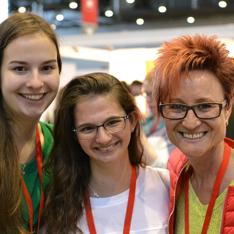R.T.-L. Zhu1, C.Z.-H. Ma1
1The Hong Kong Polytechnic University, Department of Biomedical Engineering, Kowloon, Hong Kong
Background: Falls lead to adverse consequences in older adults and a huge economic burden to society. By comparing the different strategies for maintaining postural balance between older adults with the high and the low risk of falls, previous studies have identified some behavioral or kinematic factors that are related to falls. However, the underlying fall-related lower-limb joint kinetics and muscle activities remain unclear.
Purpose: This study aimed to investigate whether the community-dwelling older fallers (with at least one fall in past year) and older non-fallers (without previous history of falls in the past year) have the different activation patterns at eight lower-limb muscles and the different lower-limb joint moment responses to maintain reactive standing balance.
Methods: With the sample size justified, this study enrolled 36 older fallers and 36 age-matched non-fallers. Unexpected waist-pull balance perturbations were applied to each participant during standing, and randomized in four directions (anterior, posterior, medial, and lateral) and three magnitudes (small, medium, and large). Besides the whole-body center of mass (CoM) displacement, the eight dominant-leg joint moments (i.e., hip abduction/adduction, hip flexion/extension, knee flexion/extension, and ankle dorsiflexion/plantarflexion) and the synchronized electromyographic (EMG) signals of eight dominant-leg muscles (i.e., hip abductor/adductor, hip flexor/extensor, knee flexor/extensor, and ankle dorsiflexor/plantarflexor) were collected.
Results: Preliminary results of twelve fallers (69.3 ± 3.8 years) and twelve non-fallers (71.3 ± 3.0 years) with the mean values compared were shown below.
Fallers had larger CoM displacements than non-fallers. Fallers also took more time to restabilize the CoM than non-fallers, except following the posterior perturbations.
Among the eight joint moments, larger responses occurred in the moments that followed CoM displacement. Compared with non-fallers, fallers had larger hip flexion and ankle dorsiflexion moments following anterior perturbations, larger hip extension, knee flexion, and ankle plantarflexion moments following posterior perturbations, larger hip abduction moment following medial perturbations, and smaller hip adduction moment following lateral perturbations.
Among the eight muscles, agonist muscles that resisted CoM displacement had the earlier and longer activation than antagonist muscles. Fallers had the longer EMG burst durations of agonist muscles, except following posterior perturbations. Additionally, following anterior perturbations, fallers had the earlier EMG onset and the longer EMG burst durations of hip extensor and knee flexor than non-fallers.
Fallers had larger CoM displacements than non-fallers. Fallers also took more time to restabilize the CoM than non-fallers, except following the posterior perturbations.
Among the eight joint moments, larger responses occurred in the moments that followed CoM displacement. Compared with non-fallers, fallers had larger hip flexion and ankle dorsiflexion moments following anterior perturbations, larger hip extension, knee flexion, and ankle plantarflexion moments following posterior perturbations, larger hip abduction moment following medial perturbations, and smaller hip adduction moment following lateral perturbations.
Among the eight muscles, agonist muscles that resisted CoM displacement had the earlier and longer activation than antagonist muscles. Fallers had the longer EMG burst durations of agonist muscles, except following posterior perturbations. Additionally, following anterior perturbations, fallers had the earlier EMG onset and the longer EMG burst durations of hip extensor and knee flexor than non-fallers.
Conclusions: Joint moments driving the CoM displacement were generally larger in fallers, and this may explain their larger postural sways than non-fallers following unexpected perturbations. Fallers had longer EMG burst durations of agonist muscles to resist the anterior, medial, and lateral perturbations, which may account for their slower recovery of postural sways compared to non-fallers. Specifically, fallers prioritized the proximal agonist muscles to recover from the anterior loss of balance, while non-fallers prioritized the distal muscles.
Implications: The larger joint moments and the longer activation of agonist muscles in fallers indicate their ineffective strategy to resist the unexpected balance perturbations. When confronting the sudden anterior loss of balance, fallers even tend to use the proximal lower-limb muscles. These fall-related factors may be potentially modifiable for the further fall prevention in older adults.
Funding acknowledgements: This work was supported by The Kong Polytechnic University [grant numbers P0038945, P0036830, P0034491].
Keywords:
Falls
Balance
EMG / electromyographic
Falls
Balance
EMG / electromyographic
Topics:
Older people
Health promotion & wellbeing/healthy ageing/physical activity
Musculoskeletal: lower limb
Older people
Health promotion & wellbeing/healthy ageing/physical activity
Musculoskeletal: lower limb
Did this work require ethics approval? Yes
Institution: The Hong Kong Polytechnic University
Committee: Institutional Review Board
Ethics number: HSEARS20220409002-02
All authors, affiliations and abstracts have been published as submitted.

